INTRODUCTION
In April 2022, at least 169 cases of acute hepatitis of unknown origin had been reported from 11 countries to World Health Organization (WHO) (WHO, 2022). As of 9 May, Indonesia has logged 15 cases (Kiki Siregar, 2022). The clinical syndrome among globally identified cases is acute hepatitis (liver inflammation) with markedly increased hepatic enzymes. Those affected children were between 1 month old and 16 years old. According to the WHO, a worldwide outbreak of severe hepatitis has claimed many lives, including children in Indonesia. Hepatitis B virus (HBV) and hepatitis C virus (HCV) infections are also important causes of hepatocellular carcinoma (HCC), which has a rising global prevalence and is a fatal and burdensome form of liver cancer. In Asia, liver cancer is the fifth most common cancer and the second most common cause of cancer-related death (Abasseri et al., 2023; Liu and Liu, 2022).
In those conditions, hepatoprotective agents are needed to promote liver health. Many herbs have been used to protect liver tissues, such as Curcuma longa and Curcuma xanthorrhiza. In vitro and in vivo studies have revealed the mechanisms of action of C. longa and C. xanthorrhiza. Based on the study results, both herbs have anti-inflammatory and antioxidant effects that are beneficial in maintaining liver function (Oon et al., 2015; Salama et al., 2013).
In addition to C. longa and C. xanthorrhiza, Phyllanthus niruri (meniran) belongs to the Euphorbiaceae family (Jantan et al., 2019) also has anti-inflammatory and antioxidant properties (Bagalkotkar et al., 2010), besides immunomodulatory activity (Dirjomuljono et al., 2008; Tjandrawinata et al., 2017). The previous study demonstrated that the protein fraction of P. niruri was effective in protecting liver tissues against oxidative stress in mice. Increased antioxidant defenses are thought to be responsible (Bhattacharjee and Sil, 2006). Tewari et al. (2017) and Venkateswaran et al. (1987) also described that P. niruri might have a role in inhibiting the replication of the HBV. In terms of safety, Phyllanthus species, including P. niruri, were proven to lack adverse reactions. Various clinical studies demonstrated that P. niruri has a good safety profile and many potential clinical benefits, including its efficacy in hepatitis (Dirjomuljono and Tjandrawinata, 2011; Tjandrawinata et al., 2005).
Therefore, P. niruri is suspected of having bioactive compounds in various hepatoprotective-related signaling pathways. However, the chemical constituents, the target proteins, and the signaling pathways responsible for hepatoprotective activities are still unknown. The molecular mechanisms by which P. niruri exerts its hepatoprotective effect have never been investigated. Using network pharmacology and molecular docking studies, we could reveal the crucial components, the potential target proteins, and the molecular mechanisms of P. niruri involved in hepatoprotective activities, which can be used as a guide to further develop this herb as a new and prospective hepatoprotective drug.
MATERIALS AND METHODS
All data in this research were collected and analyzed from April until June 2022. This study was carried out in several stages; refer to studies of Li et al. (2019) and Tjandrawinata et al. (2022) (Fig. 1) (Li et al., 2019; Tjandrawinata et al., 2022; Vengolis, 2013) as follows.
Bioactive components collection and screening
Components of P. niruri were obtained from Dr. Duke’s phytochemical and ethnobotanical databases (https://phytochem.nal.usda.gov/phytochem/search), Bioinformatic analysis tool for molecular mechanism of traditional Chinese medicine (BATMAN-TCM, http://bionet.ncpsb.org.cn/batman-tcm/), KNApSAcK Core System
(http://www.knapsackfamily.com/knapsack_core/top.php), Chemical Entities of Biological Interest (ChEBI, https://www.ebi.ac.uk/chebi/), and literature of the previous study of P. niruri phytochemicals (Feng et al., 2018; Lem et al., 2022; Wadhawan et al., 2021). The bioactive components were selected from all components with oral bioavailability (OB) ≥30% and drug-likeness (DL) ≥0.18 in the traditional Chinese medicine systems pharmacology database and analysis platform (TCMSP, https://tcmsp-e.com/tcmsp.php) or components that passed Lipinski’s rule of five for DL of OB in SwissADME (http://www.swissadme.ch/index.php) using each canonical simplified molecular input line entry system (canonical SMILES) obtained from PubChem (https://pubchem.ncbi.nlm.nih.gov/).
A high probability of being of being an oral drug (or the DL) is indicated by molecular weight <500 Da, MLOGP ≤4.15, number of H-bond acceptors ≤10, and number of H-bond donors ≤5 (Daina et al., 2017; Jia et al., 2021; Lipinski et al., 2001; Ranjith and Ravikumar, 2019; Zhang et al., 2019; Zhou et al., 2022).
Phyllanthus niruri-related target proteins collection and screening
Phyllanthus niruri-related target proteins were collected from Similarity Ensemble Approach (https://sea.bkslab.org/) and the SwissTargetPrediction platform (http://www.swisstargetprediction.ch/) by input canonical SMILES, which were obtained from PubChem for each bioactive component of P. niruri (Wadhawan et al., 2021). Target protein collection was limited in Homo sapiens (human) and Tanimoto coefficient (TC) or probability of drug similarity ≥0.5 (Rahman et al., 2022). A similarity threshold for TC is different in several studies. However, the common range applied is 0.5–0.85. As a note, the higher the threshold, the fewer predicted target proteins (Gottlieb et al., 2012; Rahman et al., 2022). Target proteins collected from both databases were combined and removed for duplicate targets (Jia et al., 2021; Zhou et al., 2022). Those target protein names should be standardized using the UniProt database [https://beta.uniprot.org/] [Wadhawan et al., 2021].
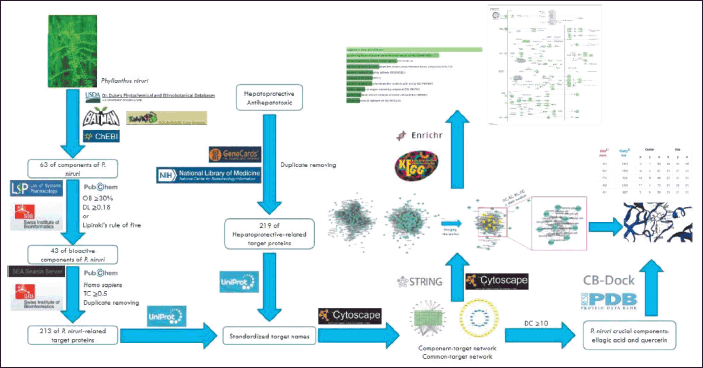 | Figure 1. The workflow diagram of network pharmacology study and molecular docking validation of P. niruri on hepatoprotective activities. [Click here to view] |
Hepatoprotective-related target proteins collection and screening
Hepatoprotective-related target proteins were obtained from the GeneCards database [https://www.genecards.org] and the National Center for Biotechnology Information Gene (NCBI Gene, https://www.ncbi.nlm.nih.gov/gene/) (Li et al., 2019; Zhou et al., 2022) using keywords of “hepatoprotective” and “antihepatotoxic”. Target proteins collected from both databases were combined and removed for duplicate targets, then those target protein names should be standardized using the UniProt database [Wadhawan et al., 2021].
Component-target network and common-target network construction
Phyllanthus niruri-related target proteins and the bioactive components of P. niruri were collected to build a component-target network using Cytoscape v3.9.1 (https://cytoscape.org/). Phyllanthus niruri-related target proteins and the bioactive components of P. niruri were represented as nodes, while the interactions between them were represented as edges (Wadhawan et al., 2021).
The intersection of P. niruri-related target proteins and hepatoprotective-related target proteins was used to construct a common-target network using Cytoscape v3.9.1. This common-target network might be analyzed to determine the important proteins, i.e., the nodes with degree ≥ median degree. The greater number of important proteins were the target of a component; the component could be considered crucial (Li et al., 2019).
Protein-protein interaction (PPI) network
Phyllanthus niruri-related target proteins and hepatoprotective-related target proteins were used to build PPI networks using the STRING database [https://www.string-db.org/]. Homo sapiens (human) organisms with medium confidence of 0.400 were selected as a limitation (Zhang et al., 2019). PPI network from the STRING database was downloaded in tab-separated value format and visualized into Cytoscape v3.9.1 (Jia et al., 2021; Zhou et al., 2022). Both PPI networks were merged in Cytoscape to obtain the intersection. Then, the merging intersection was analyzed using CytoNCA, a plug-in of Cytoscape, resulting in the important proteins. Target proteins should be eliminated when they do not meet the screening criteria of “degree centrality (DC), eigenvector centrality (EC), betweenness centrality (BC), and closeness centrality (CC) are greater than or equal to their median.” The remaining target proteins were determined as the important proteins (Li et al., 2019).
Enrichment analysis
Phyllanthus niruri-and hepatoprotective-related important proteins were further analyzed to result in information on biological processes (BPs), molecular functions (MFs), cellular components (CCs), and signaling pathways regarding potential hepatoprotective activities using Enrichr (https://amp.pharm.mssm.edu/Enrichr/) andKyoto encyclopedia of genes and genomes (KEGG)PATHWAY database [https://www.genome.jp/kegg/pathway.html]with p-value ≤0.05 (Jia et al., 2021; Li et al., 2019; Shahid et al., 2021; Zhang et al., 2019).
Molecular docking validation
This approach aimed to confirm the network pharmacology study. The crucial components obtained from network pharmacology were used as small molecular ligands to perform molecular docking with potential target proteins. We used the PubChem database to download the 2D structures of ligands in structure-data file format. The 3D structures of receptor proteins were searched in the UniProt database linked directly to Research Collaboratory for Structural Bioinformatics Protein Data Bank (https://www.rcsb.org/) (Rahardjo et al., 2020; Ramdani et al., 2019) to be downloaded in PDB format. After removing the original ligands and water molecules by University of California, San Francisco Chimera v.1.16 (https://www.cgl.ucsf.edu/chimera/download.html), we obtained receptor protein structure.
To predict the binding regions of a target protein and to calculate the centers and sizes to obtain the best pose with the smallest binding energy, we employed the server of CB-Dock (http://clab.labshare.cn/cb-dock/php/). CB-Dock ranked the binding modes according to Vina score and showed an interactive 3D visualization of the binding modes (Liu et al., 2020). Based on the principle of molecular docking, the most negative value of energy (shown as the Vina score) indicates the most stable ligand structure (Abbas et al., 2018). If the minimum binding energy is less than −5.0, it implies that ligand-receptor binding activity is high (Lin et al., 2021; Zhou et al., 2022).
RESULTS
Data collection and screening
In total, 63 components of P. niruri were collected from the previous phytochemical studies and 4 natural product databases, including Dr. Duke’s phytochemical and ethnobotanical databases, BATMAN-TCM, KNApSAcK core system, and ChEBI (Supplementary Table S1). A total of 43 bioactive components were selected from 63 components according to 2 types of criteria (Supplementary Table S2). First, the criteria from the TCMSP database, including OB ≥30% and DL ≥0.18. Second, the compounds unavailable in the TCMSP database were screened by the criteria of Lipinski’s rule of five from SwissADME.
Network construction
From 43 bioactive components of P. niruri, we collected 380 target proteins. After removing duplicates, we obtained 213 target proteins (Supplementary Table S3a and b). Subsequently, we constructed a P. niruri component-target network containing 236 nodes and 380 edges using Cytoscape v3.9.1 (Fig. 2).
After deleting duplicates, this study collected 219 hepatoprotective-related target proteins from 2 human genomic databases (Supplementary Table S4). The amount of these target proteins in GeneCards and NCBI Gene was 224 and 15, respectively. A total of 32 from 219 target proteins were related to 14 bioactive components of P. niruri (Supplementary Table S5a and b, as well as Fig. 3).
Furthermore, we analyzed the common-target network using the criteria of DC. Degree centrality reflects the importance of nodes. The greater DC indicates the more connections a molecule has and the more important it is. With criteria of DC ≥10, we selected ellagic acid (PubChem ID: 5281855) and quercetin (PubChem ID: 5280343) as crucial components of P. niruri.
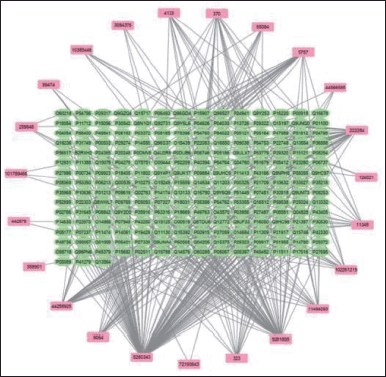 | Figure 2. Phyllanthus niruri component-target network, containing 236 nodes and 380 edges; pink nodes and green nodes stand for bioactive components of P. niruri and target proteins, respectively. [Click here to view] |
The PPI network of P. niruri- and hepatoprotective-related target proteins were constructed using the STRING database and visualized in Cytoscape v3.9.1. We merged and obtained the intersection of both PPI networks. We analyzed the merging intersection of the PPI network by using CytoNCA, a plug-in of Cytoscape. The screening criteria we used were “DC, EC, BC, and CC greater than or equal to their median.” Subsequently, we obtained nine potential target proteins (Supplementary Table S6 and Fig. 4).
Enrichment analysis
We input nine potential target proteins into Enrichr for enrichment analysis, resulting in 568 BPs, 63 MFs, 19 CCs, and 139 KEGG pathways, as shown in Supplementary Tables S7–S10, respectively. The top 10 BPs, MFs, CCs, and signaling pathways are shown in Figure 5.
Molecular docking validation
Molecular docking results are shown in Table 1 and Figure 6.
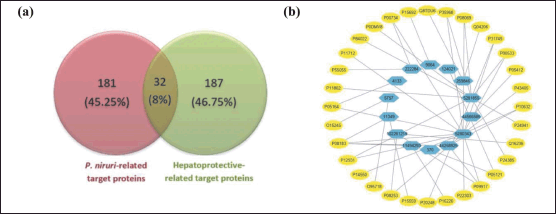 | Figure 3. Common-target network. (a) Venn diagram, including 32 target proteins that are related to P. niruri and hepatoprotective. (b) Visual common-target network, containing 46 nodes and 47 edges; blue and yellow nodes stand for the bioactive components of P. niruri and target proteins, respectively. [Click here to view] |
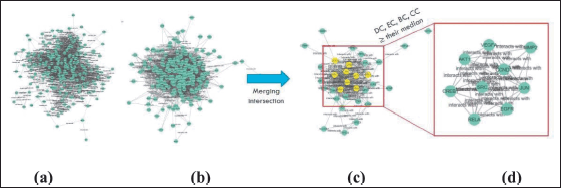 | Figure 4. PPI network of target proteins related to P. niruri and hepatoprotective. (a) PPI network of P. niruri-related target proteins (208 nodes and 1,699 edges). (b) PPI network of hepatoprotective-related target proteins (215 nodes and 4,094 edges). (c) PPI network of common target (32 nodes and 157 edges). (d) PPI network by the screening criteria of DC ≥10, EC ≥0.16039226, BC ≥6.74254615, and CC ≥0.3625855 (9 nodes and 34 edges). [Click here to view] |
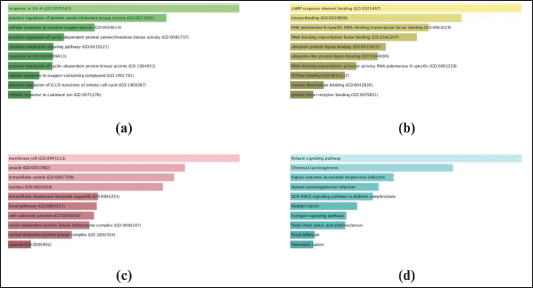 | Figure 5. Bar graph of top 10 enriched BPs, MFs, CCs, and signaling pathways (sorted by p-value ranking). (a) Bar graph of top ten enriched BPs. (b) Bar graph of top 10 enriched MFs. (c) Bar graph of top 10 enriched CCs. (d) Bar graph of top 10 enriched signaling pathways. [Click here to view] |
 | Table 1. Vina score and cavity information of the docking simulation pose for each potential target protein and crucial component of P. niruri by using CB-Dock. [Click here to view] |
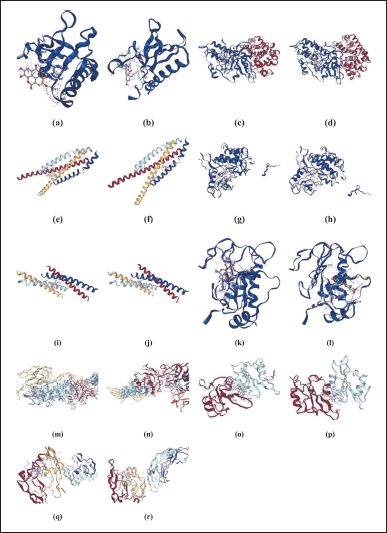 | Figure 6. Docking model diagram for each potential target protein and crucial component of P. niruri by using CB-Dock. (a) Ellagic acid-AKT1. (b) Quercetin-AKT1. (c) Ellagic acid-CCND1. (d) Quercetin-CCND1. (e) Ellagic acid-CREB1. (f) Quercetin-CREB1. (g) Ellagic acid-EGFR. (h) Quercetin-EGFR. (i) Ellagic acid-JUN. (j) Quercetin-JUN. (k) Ellagic acid-MMP2. (l) Quercetin-MMP2. (m) Ellagic acid-RELA. (n) Quercetin-RELA. (o) Ellagic acid-SRC. (p) Quercetin-SRC. (q) Ellagic acid-VEGFA. (r) Quercetin-VEGFA. [Click here to view] |
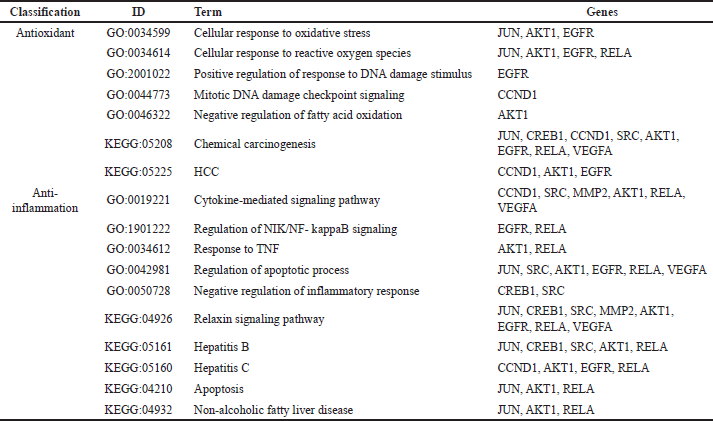 | Table 2. Functions of nine potential target proteins of P. niruri based on GO and KEGG pathway analyses through Enrichr. [Click here to view] |
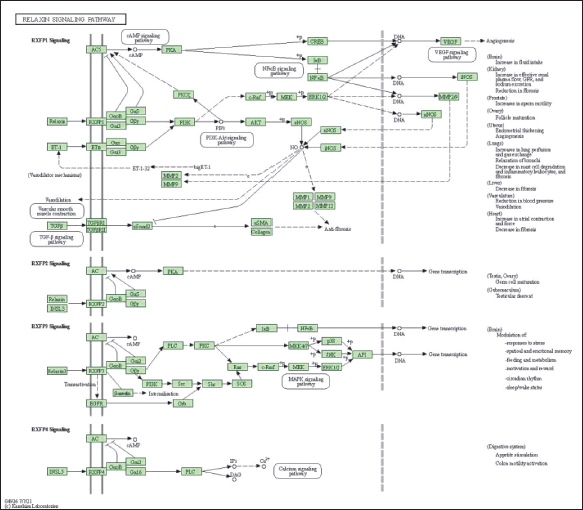 | Figure 7. Relaxin signaling pathway (KEGG:04926). [Click here to view] |
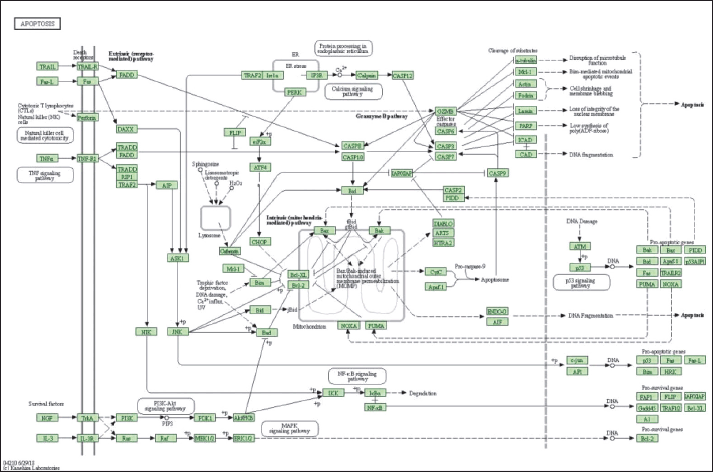 | Figure 8. Apoptosis pathway (KEGG:04210). [Click here to view] |
DISCUSSION
The two crucial components of P. niruri, namely, ellagic acid and quercetin, and the nine potential target proteins of AKT1, JUN, VEGFA, EGFR, CCND1, SRC, CREB1, MMP2, and RELA, were successfully identified in this network pharmacology study. The DC, EC, BC, and CC of those nine target proteins were greater than or equal to their median. The higher all those topological parameters indicate the more important the target proteins (nodes) (Li et al., 2019; Wadhawan et al., 2021).
Based on the gene ontology (GO) and KEGG pathway analyses, the nine potential target proteins’ BPs and signaling pathways could be categorized into two primary pharmacological activities, i.e., antioxidant and anti-inflammation, as shown in Table 2.
As a typical wound-healing response to tissue injury, all hepatocellular pathways are commonly activated in chronic liver injuries. This is known as fibrogenesis, and it occurs when fibrogenic extracellular matrix (ECM) components are secreted to enclose and isolate the injured area of the tissue for repair (Acharya et al., 2021). Hepatic stellate cells transform into myofibroblasts after sustained liver injury, express alpha-smooth muscle actin, move to tissue healing sites, and release substantial amounts of ECM (Rachmawati et al., 2017; Sundari et al., 2018). According to this study, P. niruri possessed target proteins related to the prohibition of fibrogenesis response-mediating proteins. The relaxin signaling pathway (KEGG:04926) involved several target genes such as JUN, CREB1, SRC, MMP2, AKT1, EGFR, RELA, and VEGFA, which could explain this process, as shown in Figure 7.
Elevated reactive oxygen species (ROS) are the primary cause of liver fibrosis (Rachmawati et al., 2017). As demonstrated in Figure 8, ROS-induced hepatocyte apoptosis (KEGG:04210) might be the protective mechanism, resulting in the release of damaging mediators (e.g., TGF-β, TNF-α) (Sundari et al., 2018; Wardhani et al., 2020). Proapoptotic proteins, such as p53, CASP9, Fas, Fas-L, and Bax, are upregulated in regulating the apoptotic process (GO:0042981). Antiapoptotic proteins like Bcl2, on the other hand, are downregulated (Dhar et al., 2020; Tandrasasmita et al., 2010). Free radical activity has also been observed to be scavenged by ellagic acid (Aishwarya et al., 2021). This mechanism of action could be elicited by the BPs of cellular response to oxidative stress (GO:0034599) and cellular response to ROS (GO:0034614) that involved target genes of JUN, AKT1, EGFR, and RELA. HCV (KEGG:05160) and HBV (KEGG:05161) infections, as well as non-alcoholic fatty liver disease (GO:0046322, and KEGG:04932), also contributed to liver fibrosis (Dhar et al., 2020; Sundari et al., 2018).
As previously mentioned, ROS influenced the regulation of inflammatory response (GO:0050728). Overexpression of inflammatory mediators was closely associated with the inflammatory disease; therefore, NF-κB-Inducing Kinase (NIK)/NF-κB (GO:1901222), cytokine-mediated signaling (GO:0019221), and response to tumor necrosis factor (TNF) (GO:0034612) should be modulated (Pflug and Sitcheran, 2020; Yuliana et al., 2022). The previous study reported that the presence of fibrosis affected the development of HCC (Dhar et al., 2020; Wardhani et al., 2020). This study found that P. niruri also has target genes involved in the HCC pathway (KEGG:05225), including CCND1, AKT1, and EGFR. HCC is the most common type of liver cancer (Dhar et al., 2020), which is generally caused by DNA damage. Intriguingly, ellagic acid can prevent the binding of carcinogens to DNA (Bagalkotkar et al., 2010). This property has a close relationship with inhibiting DNA damage activities through various BPs and signaling pathways, including any process that activates or increases the frequency, rate, or extent of the response to DNA damage stimulus (GO:2001022); signal transduction process involved in mitotic DNA damage checkpoint (GO:0044773); and ROS-induced chemical carcinogenesis pathway (KEGG:05208).
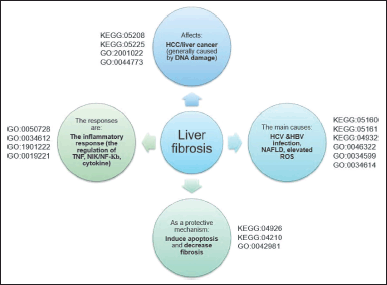 | Figure 9. The summary of BPs and signaling pathways of P. niruri target proteins in hepatoprotective activities. [Click here to view] |
Ellagic acid and quercetin, which were identified as crucial components, were predicted to have a substantial role in P. niruri of antioxidant and anti-inflammatory effects, based on previous studies (Aishwarya et al., 2021; Bagalkotkar et al., 2010). Ellagic acid and quercetin have a promising role in preventing liver disease through various mechanisms of action (Aishwarya et al., 2021; Bagalkotkar et al., 2010; Tewari et al., 2017). According to the findings of this network pharmacology investigation, the modes of action are similar to those of C. longa and C. xanthorrhiza in protecting liver tissues (Devaraj et al., 2014; Ibrahim et al., 2020; Karamalakova et al., 2019; Oon et al., 2015; Rivera-Espinoza and Muriel, 2009; Salama et al., 2013). The molecular docking study confirmed this result. Our study found that CCND1 and RELA are the key targets of P. niruri in protecting liver tissues and have high binding activities with ellagic acid and quercetin.
This network pharmacology and molecular docking study revealed the BPs, target proteins, and signaling pathways to more comprehensively elucidate the ellagic acid and quercetin modes of action from upstream to downstream. We can develop a new therapeutic intervention that may be advantageous in treating liver fibrosis by better understanding the signaling pathways and target proteins of P. niruri in hepatoprotective activities and the interactions among their target proteins (Fig. 9). Eventually, it leads to promising hepatoprotective agent development.
CONCLUSION
In conclusion, our study found that CCND1 and RELA are the key targets of P. niruri in protecting liver tissues. They are both involved in many BPs and signaling pathways related to hepatic disease. The molecular mechanisms elicited by GO and KEGG analyses revealed similar mechanisms of action as C. longa and C. xanthorrhiza in hepatoprotective activities. In this molecular docking study, we discovered that ellagic acid and quercetin of P. niruri exhibited a high binding affinity to CCND1 and RELA. We can conclude that P. niruri, well-known for its ability to modulate the immune system, can also be a potential hepatoprotective agent like C. longa and C. xanthorrhiza. Concisely, the finding of this study can provide insight into developing a new promising hepatoprotective agent in the future. Therefore, studies of P. niruri in vitro and in vivo, especially those examining the effects of ellagic acid and quercetin on target proteins CCND1 and RELA, are suggested to be carried out for further confirmation.
ACKNOWLEDGMENTS
This research is supported by PT Dexa Medica, Indonesia.
AUTHORS’ CONTRIBUTIONS
S.T. searched the databases and references, collected and analyzed the data, developed the method, created the illustrations, and drafted the manuscript. A.Y. suggested the research topic and provided technical support. R.R.T was responsible for the funding and supervising. All authors reviewed the manuscript and provided insightful revision recommendations.
CONFLICTS OF INTEREST
The authors declare no conflicts of interest.
ETHICAL APPROVAL
This study does not involve any animals or human subjects.
DATA AVAILABILITY
All data generated and analyzed are included in this research article.
PUBLISHER’S NOTE
This journal remains neutral with regard to jurisdictional claims in published institutional affiliation.
REFERENCES
Abasseri M, Hoque S, Slavica Kochovska B, Caldwell K, Sheahan L, Zekry A. Barriers to palliative care in hepatocellular carcinoma: a review of the literature. J Gastroenterol Hepatol, 2023; 38:1–9.
Abbas A, Agusta MK, Dipojono H, Saputro AG, Rachmawati H, Ismaya WT. Preliminary insight into recognizing of mannose toward LSMT protein: molecular docking and DFT study. J Appl Phys Sci, 2018; 4:95–100.
Acharya P, Chouhan K, Weiskirchen S, Weiskirchen R. Cellular mechanisms of liver fibrosis. Front Pharmacol, 2021; 12:671640.
Aishwarya V, Solaipriya S, Sivaramakrishnan V. Role of ellagic acid for the prevention and treatment of liver diseases. Phytother Res, 2021; 35:2925–44.
Bagalkotkar G, Sagineedu SR, Saad MS, Stanslas J. Phytochemicals from Phyllanthus niruri Linn. and their pharmacological properties: a review. J Pharm Pharmacol, 2010; 58:1559–70.
Bhattacharjee R, Sil PC. The protein fraction of Phyllanthus niruri plays a protective role against acetaminophen induced hepatic disorder via its antioxidant properties. Phytother Res, 2006; 20:595–601.
Daina A, Michielin O, Zoete V. SwissADME: a free web tool to evaluate pharmacokinetics, drug-likeness and medicinal chemistry friendliness of small molecules. Sci Rep, 2017; 7:42717.
Devaraj S, Ismail S, Ramanathan S, Yam MF. Investigation of antioxidant and hepatoprotective activity of standardized Curcuma xanthorrhiza rhizome in carbon tetrachloride-induced hepatic damaged rats. Sci World J, 2014; 2014:1–8.
Dhar D, Baglieri J, Kisseleva T, Brenner DA. Mechanisms of liver fibrosis and its role in liver cancer. Exp Biol Med (Maywood), 2020; 245:96–108.
Dirjomuljono M, Kristyono I, Tjandrawinata RR, Nofiarny D. Symptomatic treatment of acute tonsillo-pharyngitis patients with a combination of Nigella sativa and Phyllanthus niruri extract. CP, 2008; 46:295–306.
Dirjomuljono M, Tjandrawinata RR. Clinical trials involving Phyllanthus species, in book: Phyllanthus species: scientific evaluation and medicinal applications. CRC Press, Boca Raton, FL, 2011.
Feng W, Ao H, Yue S, Peng C. Systems pharmacology reveals the unique mechanism features of Shenzhu capsule for treatment of ulcerative colitis in comparison with synthetic drugs. Sci Rep, 2018; 8:16160.
Gottlieb A, Stein GY, Oron Y, Ruppin E, Sharan R. INDI: a computational framework for inferring drug interactions and their associated recommendations. Mol Syst Biol, 2012; 8:592.
Ibrahim J, Kabiru AY, Abdulrasheed-Adeleke T, Lawal B, Adewuyi AH. Antioxidant and hepatoprotective potentials of curcuminoid isolates from turmeric (Curcuma longa) rhizome on CCl4-induced hepatic damage in Wistar rats. J Taibah Univ Sci, 2020; 14:908–15.
Jantan I, Haque MdA, Ilangkovan M, Arshad L. An insight into the modulatory effects and mechanisms of action of Phyllanthus species and their bioactive metabolites on the immune system. Front Pharmacol, 2019; 10:878.
Jia C, Pan X, Wang B, Wang P, Wang Y, Chen R. Mechanism prediction of Astragalus membranaceus against cisplatin-induced kidney damage by network pharmacology and molecular docking. Evid Based Complement Altern Med, 2021; 2021:1–15.
Karamalakova YD, Nikolova GD, Georgiev TK, Gadjeva VG, Tolekova AN. Hepatoprotective properties of Curcuma longa L. extract in bleomycin-induced chronic hepatotoxicity. Drug Discov Ther, 2019; 13:9–16.
Kiki Siregar. Indonesia Logs 15 cases of acute hepatitis with unknown cause [Online]. 2022. Available via https://www.channelnewsasia.com/asia/indonesia-logs-15-cases-acute-hepatitis-unknown-cause-2673496 (Accessed 10 June 2022).
Lem FF, Lee DJH, Chee FT, Chin SN, Lin KM, Yew CW. Network pharmacology approach to reveals therapeutic mechanism of traditional plants formulation used by Malaysia indigenous ethnics in coronaviruses infection (preprint). Chemistry, 2022:1–18.
Li F, Duan J, Zhao M, Huang S, Mu F, Su J, Liu K, Pan Y, Lu X, Li J, Wei P, Xi M, Wen A. A network pharmacology approach to reveal the protective mechanism of Salvia miltiorrhiza-Dalbergia odorifera coupled-herbs on coronary heart disease. Sci Rep, 2019; 9:19343.
Lin Y, Shen C, Wang F, Fang Z, Shen G. Network pharmacology and molecular docking study on the potential mechanism of Yi-Qi-Huo-Xue-Tong-Luo formula in treating diabetic peripheral neuropathy. J Diabetes Res, 2021; 2021:1–16.
Lipinski CA, Lombardo F, Dominy BW, Feeney PJ. Experimental and computational approaches to estimate solubility and permeability in drug discovery and development settings. Adv Drug Deliv Rev, 2001; 46:3–26.
Liu Y, Grimm M, Dai W, Hou M, Xiao ZX, Cao Y. CB-Dock: a web server for cavity detection-guided protein–ligand blind docking. Acta Pharmacol Sin, 2020 41:138–44.
Liu Y, Liu L. Changes in the epidemiology of hepatocellular carcinoma in Asia. Cancers, 2022; 14:4473.
Oon SF, Nallappan M, Tee TT, Shohaimi S, Kassim NK, Sa’ariwijaya MSF, Cheah YH. Xanthorrhizol: a review of its pharmacological activities and anticancer properties. Cancer Cell Int, 2015; 15:100.
Pflug KM, Sitcheran R. Targeting NF-κB-inducing kinase (NIK) in immunity, inflammation, and cancer. IJMS, 2020; 21:8470.
Rachmawati H, Novel MA, Nisa RM, Berlian G, Tandrasasmita OM, Rahma A, Riani C, Tjandrawinata RR. Co-delivery of curcumin-loaded nanoemulsion and Phaleria macrocarpa extract to NIH 3T3 cell for antifibrosis. J Drug Deliv Sci Technol, 2017; 39:123–30.
Rahardjo NW, Ramdani ED, Tjandrawinata RR. Metabolomic study and in silico approach of DLBS1442 as progesterone receptor agonist. J App Pharm Sci, 2020; 10:63–9.
Rahman, MdM, Vadrev SM, Magana-Mora A, Levman J, Soufan O. A novel graph mining approach to predict and evaluate food-drug interactions. Sci Rep, 2022; 12:1061.
Ramdani ED, Yanuar A, Tjandrawinata RR. Comparison of dopamine D2 receptor (homology model and X-ray structure) and virtual screening protocol validation for the antagonism mechanism. J App Pharm Sci, 2019; 9:17–22.
Ranjith D, Ravikumar C. SwissADME predictions of pharmacokinetics and drug-likeness properties of small molecules present in Ipomoea mauritiana Jacq. J Pharmacogn Phytochem, 2019; 8:2063–73.
Rivera-Espinoza Y, Muriel P. Pharmacological actions of curcumin in liver diseases or damage. Liver Int, 2009; 29:1457–66.
Salama SM, Abdulla MA, AlRashdi AS, Ismail S, Alkiyumi SS, Golbabapour S. Hepatoprotective effect of ethanolic extract of Curcuma longa on thioacetamide induced liver cirrhosis in rats. BMC Complement Altern Med, 2013; 13:56.
Shahid M, Azfaralariff A, Law D, Najm AA, Sanusi SA, Lim SJ, Cheah YH, Fazry S. Comprehensive computational target fishing approach to identify xanthorrhizol putative targets. Sci Rep, 2021; 11:1594.
Sundari N, Soetikno V, Louisa M, Wardhani BW, Tjandrawinata RR. Protective effect of Phaleria macrocarpa water extract (proliverenol) against carbon tetrachloride-induced liver fibrosis in rats: role of TNF-α and TGF-β 1. J Toxicol, 2018; 2018:1–7.
Tandrasasmita OM, Lee JS, Baek SH, Tjandrawinata RR. Induction of cellular apoptosis in human breast cancer by DLBS1425, a Phaleria macrocarpa compound extract, via down-regulation of PI3-kinase/AKT pathway. Cancer Biol Ther, 2010; 10:814–23.
Tewari D, Mocan A, Parvanov ED, Sah AN, Nabavi SM, Huminiecki L, Ma ZF, Lee YY, Horba?czuk JO, Atanasov AG. Ethnopharmacological approaches for therapy of jaundice: part II. highly used plant species from Acanthaceae, Euphorbiaceae, Asteraceae, Combretaceae, and Fabaceae families. Front Pharmacol, 2017; 8:519.
Tjandrawinata RR, Amalia AW, Tuna H, Said VN, Tan S. Molecular mechanisms of network pharmacology-based immunomodulation of huangqi (Astragali Radix). J Ilmu Kefarmasian Indones, 2022; 20:184–95.
Tjandrawinata R, Nofiarny D, Maat S. Effects of standardized Phyllantus niruri extract on changes in immunological parameters: correlation between pre-clinical and clinical studies. Medika, 2005; 31:367–71.
Tjandrawinata RR, Susanto LW, Nofiarny D. The use of Phyllanthus niruri L. as an immunomodulator for the treatment of infectious diseases in clinical settings. APJTD, 2017; 7:132–40.
Vengolis. English: Phyllanthus niruri [Online]. 2013. Available via https://commons.wikimedia.org/wiki/File:Phyllanthus_niruri_03520.jpg.
Venkateswaran PS, Millman I, Blumberg BS. Effects of an extract from Phyllanthus niruri on hepatitis B and woodchuck hepatitis viruses: in vitro and in vivo studies. Proc Natl Acad Sci USA, 1987; 84:274–8.
Wadhawan M, Chhabra V, Katiyar A, Sharma V, Khuntia BK, Rathore S, Kaur P, Sharma G. A network pharmacology-based approach to explore therapeutic mechanism of Indian herbal formulation Nisha Amalaki in treating type 2 diabetes mellitus (preprint). Research Square, 2021:1–30.
Wardhani BW, Sundari N, Tjandrawinata RR, Jusuf AA, Soetikno V, Louisa M. Antifibrotic activity of Phaleria macrocarpa extract in rat liver-fibrosis model: focus on oxidative stress markers, TGF-β1 and MMP-13. Open Access Maced J Med Sci, 2020; 8:555–62.
WHO. Multi-country—acute, severe hepatitis of unknown origin in children [Online]. 2022. Available via https://www.who.int/emergencies/disease-outbreak-news/item/2022-DON376 (Accessed 11 June 2022).
Yuliana Y, Tandrasasmita OM, Tjandrawinata RR. Anti-inflammatory effect of predimenol, a bioactive extract from Phaleria macrocarpa, through the suppression of NF-κB and COX-2. Recent Adv Inflamm Allergy Drug Discov, 2022; 15:99–107.
Zhang Y, Jiang W, Xia Q, Qi J, Cao M. Pharmacological mechanism of Astragalus and Angelica in the treatment of idiopathic pulmonary fibrosis based on network pharmacology. Eur J Integr Med, 2019; 32:101003.
Zhou P, Zhou R, Min Y, An LP, Wang F, Du QY. Network pharmacology and molecular docking analysis on pharmacological mechanisms of Astragalus membranaceus in the treatment of gastric ulcer. Evid Based Complement Altern Med, 2022; 2022:1–11.
APPENDIXES
All data generated or analyzed during this study are included in this published article and its Supplementary Tables.